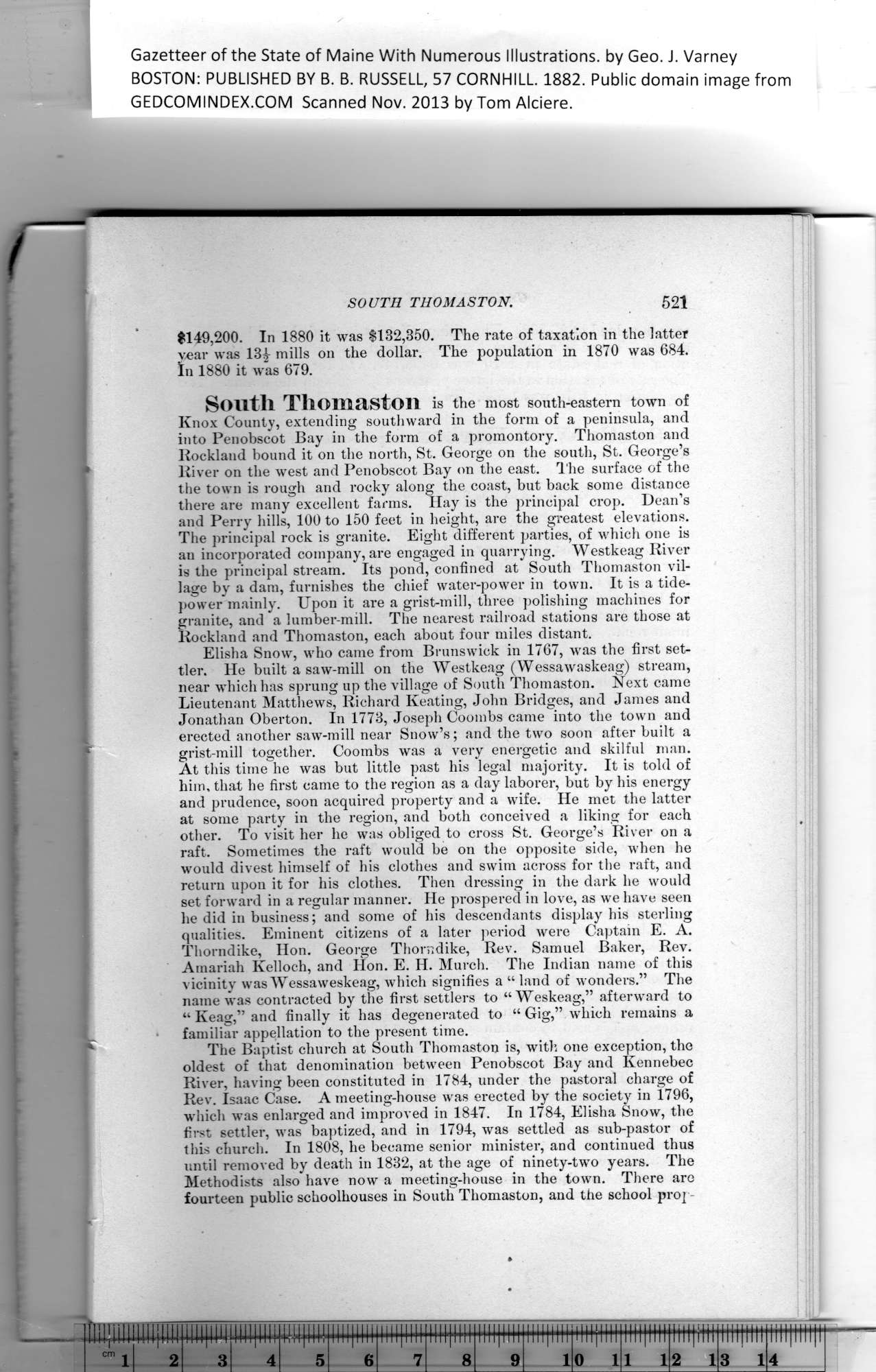|
Gazetteer of the State of Maine With Numerous Illustrations, by Geo. J. Varney
BOSTON: PUBLISHED BY B. B. RUSSELL, 57 CORNHILL. 1882. Public domain image from
SOUTH THOMASTON. 521
$149,200. In 1880 it was $132,350. The rate of taxation in the latter
year was 13£ mills on the dollar. The population in 1870 was 684.
In 1880 it was 679.
South Thomaston is the most south-eastern town of
Knox County, extending southward in the form of a peninsula, and
into Penobscot Bay in the form of a promontory. Thomaston and
Rockland bound it on the north, St. George on the south, St. George’s
River on the west and Penobscot Bay on the east. The surface of the
the town is rough and rocky along the coast, but back some distance
there are many excellent farms. Hay is the principal crop. Dean’s
and Perry hills, 100 to 150 feet in height, are the greatest elevations.
The principal rock is granite. Eight different parties, of which one is
an incorporated company, are engaged in quarrying. Westkeag River
is the principal stream. Its pond, confined at South Thomaston vil-
lage by a dam, furnishes the chief water-power in town. It is a tide-
power mainly. Upon it are a grist-mill, three polishing machines for
granite, and "a lumber-mill. The nearest railroad stations are those at
Rockland and Thomaston, each about four miles distant.
Elisha Snow, who came from Brunswick in 1767, was the first set-
tler. He built a saw-mill on the Westkeag (Wessawaskeag) stream,
near which has sprung up the village of South Thomaston. Next came
Lieutenant Matthews, Richard Keating, John Bridges, and James and
Jonathan Oberton. In 1773, Joseph Coombs came into the town and
erected another saw-mill near Snow’s; and the two soon after built a
grist-mill together. Coombs was a very energetic and skilful man.
At this time he was but little past his legal majority. It is told of
him, that he first came to the region as a day laborer, but by his energy
and prudence, soon acquired property and a wife. He met the latter
at some party in the region, and both conceived a liking for each
other. To visit her he was obliged to cross St. George’s River on a
raft. Sometimes the raft would be on the opposite side, when he
would divest himself of his clothes and swim across for the raft, and
return upon it for his clothes. Then dressing in the dark he would
set forward in a regular manner. He prospered in love, as we have seen
he did in business; and some of his descendants display his sterling
qualities. Eminent citizens of a later period tvere Captain E. A.
Thorndike, Hon. George Thorndike, Rev. Samuel Baker, Rev.
Amariah Ivelloch, and Hon. E. IT. Murch. The Indian name of this
vicinity was Wessaweskeag, which signifies a “ land of wonders.” The
name was contracted by the first settlers to “ Weskeag,” afterward to
“ Keag,” and finally it has degenerated to “ Gig,” which remains a
familiar appellation to the present time.
The Baptist church at South Thomaston is, with one exception, the
oldest of that denomination between Penobscot Bay and Kennebec
River, having been constituted in 1784, under the pastoral charge of
Rev. Isaac Case. A meeting-house was erected by the society in 1796,
which was enlarged and improved in 1847. In 1784, Elisha Snow, the
first settler, was baptized, and in 1794, was settled as sub-pastor of
this church. In 1808, he became senior minister, and continued thus
until removed by death in 1832, at the age of ninety-two years. The
Methodists also have now a meeting-house in the town. There are
fourteen public schoolhouses in South Thomaston, and the school prop-
PREVIOUS PAGE ... NEXT PAGE
This page was written in HTML using a program written in Python 3.2
|
